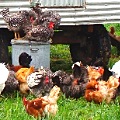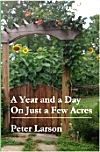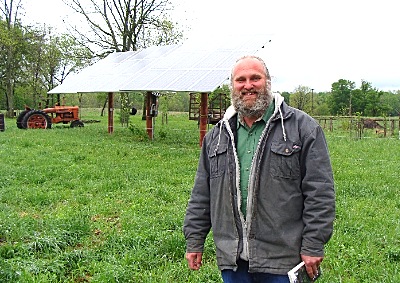- By Dan Veaner
- Around Town
 Print
Print  Many people dream of ditching modern life and going back to a more basic, pastoral dream life with a slower pace and a strong connection to family and nature. Few actually do it, in part because they don't view it a real option, and also because they need to make a living. Pete and Hilarie Larson and their three young children found a way to make it happen on a small Lansing family farm in a way that supports their family and is a living testament to their farming and world ethics.
Many people dream of ditching modern life and going back to a more basic, pastoral dream life with a slower pace and a strong connection to family and nature. Few actually do it, in part because they don't view it a real option, and also because they need to make a living. Pete and Hilarie Larson and their three young children found a way to make it happen on a small Lansing family farm in a way that supports their family and is a living testament to their farming and world ethics."I thought farming was a way to get to the heart of the matter: how we regard nature and the natural world and how we come to a healthy relationship with it," Larson says. "A lot of people push nature out of their lives and relate to it by proxy. 'I can rely on a farmer to do that for me. I can just get food from the supermarket.' Some people may say 'I don't care how the animal was raised. It's food.' OK, if you don't care about how the animal was raised you should care about the quality and flavor of the meat."
Larson left a successful career as a principal in a Syracuse architecture firm to work his family farm. His familiy is the seventh generation to work the farm his grandfather worked when Larson was a child. His father, the former Lansing Highway Superintendent, also worked the farm until the mid 1980s as an avocation while working at his full time job, but Larson had a vision of how farming a small farm could actually support his family as a full time venture. It involved creating efficiencies that allow him to raise chickens, pigs and turkeys in ways that the animals help improve the pasture that sustains them and get to live lives closer to their natural state than most farms are able to allow.
 This efficient system grows chickens in clever roving pens that work their way across the pasture, allowing the chickens to graze on the grass mix, while also fertilizing the field.
This efficient system grows chickens in clever roving pens that work their way across the pasture, allowing the chickens to graze on the grass mix, while also fertilizing the field.The self-sustaining process is a clever 'circle of life' approach. Cows 'mow' the pasture to a certain height that is perfect for chickens. The chickens are placed in roving pens on a pasture growing a mixture of alfalfa, timothy rye, orchard grass and clover. They supplement a diet of chicken feed by scratching and eating the grass mixture while further fertilizing the field. Then the pens are moved to another patch, and the process starts again as the chickens quickly grow, and so on throughout the season until they have grown enough to be slaughtered. Meanwhile a portion of the pasture is sectioned off to grow hay to feed the cows during the winter months.
"The meat chickens grow very fast and the layer chickens need so much energy to lay every day," Larson says. "They need the calories and protein from grain. We found we could reduce their feed by 30% and they get the rest from the pasture. It is one of those synergies: I'm fertilizing the pasture. I'm saving money on the feed. I'm growing a healthier meat for people to eat. And I am letting the chicken live the way its genetics tell it to live, to scratch at the dirt. And I'm cutting the grass -- I don't have to burn fuel to do that."
Larson's number one rule is 'Carry NO debt'. Savings from his architectural career helped get the family started as full time farmers last year. Rule number two, 'Maintain almost no machinery', helps them stay out of debt. The equipment they do have is like a working museum of farm equipment. Their newest tractor is 50 years old. Larson says his grandfather taught him how to restore antique tractors, and those are the machines he uses now to tow wagons, to cut firewood and occasionally to mow and put in new pasture. This year they are using the machinery to make their own hay to feed the cattle.
"People told me it takes ten years for a farmer to make a livestock profit. The way to make a profit is to minimize your infrastructure, especially equipment. We built our own infrastructure like the simple chicken boxes. We buy old, used equipment and fix it up. And we grow with cash. If I had to take on a debt load and pay interest as well as principal I couldn't do that. Last year everything that the farm made we put in the bak and used it to bootstrap ourselves. One of our rules is that we don't borrow money. We're growing as fast as our cash reserves will let us."
 Just a Few Acres Farm sells whole pastured broiler chickens, eggs, pork, shelled black walnuts, pastured broad breasted white turkeys, bourbon red turkey eggs, poults, and meat directly to local customers
Just a Few Acres Farm sells whole pastured broiler chickens, eggs, pork, shelled black walnuts, pastured broad breasted white turkeys, bourbon red turkey eggs, poults, and meat directly to local customersAnother rule is 'Create direct relationships with end consumers'. This allowed the farm to turn a small profit in its first year by selling shares using a CSA (Community Supported Agriculture) plan. Customers prepay on one of three share plans that provides chickens and eggs every month, plus a holiday turkey. It guarantees income for the farm, and provides food for shareholders 12 months per year.
"The idea behind it is you actually buy a share of the farm's production. Around here it happens a lot with produce growers," Larson explains. "We just started this year and we have 11 shareholders, but we could go quite a bit higher. You pay for feed and new animals and that money doesn't come back to you for months. The CSA system helps with that because for the most part shareholders pay up front."
Larson is a stickler for providing a natural quality of life for his livestock, which he says ix not only kinder to the animals, but also results in a better tasting bird than than large factory-style farms can grow. He likes having control over quality from start to finish.
"We do the butchering," he says. "We do the packaging. We know that it's done right."
After only a year of full time farming the Larsons are facing a confounding challenge. Government regulations exempt small farms when they slaughter 1,000 or fewer birds per year with no special facility or USDA inspector. Larson prefers slaughtering the birds outdoors with no hint of a slaughterhouse environment, which he says is an 'animal cruelty' issue. The next step of processing facility requires an enclosed 'Custom Exempt' facility with all washable surfaces and a list of other requirements.
"Ethically we have a problem with it because I regard those like hospitals," he says. "So I don't know what we're going to do because we're at that point this year. We grew really fast."
A Year and a Day on Just a Few Acres
 He says there are no slaughter houses for chickens that conform to his principals and government regulations are squeezing out small to midscale farms with the extremes of tiny output from family farms and huge numbers from factory-like farms and slaughterhouses. The compromise is a 'Custom Exempt' facility, which allows between 1,000 to 20,000 birds per year without a USDA inspector on site. One farmer told Larson he built his facility with huge windows that he opens on slaughtering day to make it more like an open air facility. But Larson laments that it still has four walls. He is looking for a creative solution that meets the standards but conforms to his principals as best as possible, but the farm's output is already to the point that he needs to go forward with this. He says a 20,000 bird facility would serve the farm, probably forever.
He says there are no slaughter houses for chickens that conform to his principals and government regulations are squeezing out small to midscale farms with the extremes of tiny output from family farms and huge numbers from factory-like farms and slaughterhouses. The compromise is a 'Custom Exempt' facility, which allows between 1,000 to 20,000 birds per year without a USDA inspector on site. One farmer told Larson he built his facility with huge windows that he opens on slaughtering day to make it more like an open air facility. But Larson laments that it still has four walls. He is looking for a creative solution that meets the standards but conforms to his principals as best as possible, but the farm's output is already to the point that he needs to go forward with this. He says a 20,000 bird facility would serve the farm, probably forever."That's about what we could grow on our 45 acre pasture," he says. "Each of those chicken boxes cross the same spot only once in a year. We just need to reconcile our own ethics with the way the government is telling us to build it and try to find a way to satisfy both."
Larson commuted from Lansing to Syracuse every day for 15 years. He specialized in designing green, sustainable buildings for schools and institutions.
"That's one of the things I used to tell clients. When you're planning to build a building it may stand 100 years. Think about that the world is going to be like in 100 years. I had the assumption that fossil fuel is going to be a lot more scarce, that things need to be more resilient for changing climate. I think it was a good way to get people out of their comfort zone."
Architecture was starting to feel outside Larson's own comfort zone. He began to feel that architects were the biggest consumers because they were making decisions about consumption patterns on a giant scale for buildings, blocks and cities. He says he felt guilty about doing that because we're still building new houses even though statistics show there are more homes in existence than people in the US. He decided to take a six month leave of absence to figure it out. He had been living in the the old farm house that had been empty since his grandfather died in 1977, and commuting to Syracuse to work. It was the longest break from work he had ever had. He remembered growing up on the farm and began reading about progressive farming techniques.
In the first few months he assumed he'd go back to the business. He began restoring old clocks to pass the time. But as the fifth month began he started thinking about expanding what he had been doing on weekends to a full time job. Hilarie had taken a leave from nursing to care for their children, but Larson says she now wants to be a full partner in the farming.
"Very quickly Hilarie and I started building the infrastructure for the farm, the chicken boxes, and buying livestock," he says. "We jumped in with both feet and started working with that full time."
Larson says he loves his new life, but there are some things that he misses. He misses doing public speaking, travel and he especially misses fresh oysters.
"I used to go to Seattle, Portland Vancouver, Washington, Philadelphia, New york and Boston fairly routinely," he says. "I'd eat at the best restaurants, stay at nice hotels. That's like a dream to me now. There are a lot of weeks where I may leave the farm once. So it's a much more focussed existence."
But he adds that he doesn't miss vacation time because what he would do on vacation is what he now does full time. He is near his family every day, and doesn't view the work he does as work. He also loves feeling like he is part of a place that his busy life as an architect didn't allow.
 Pete Larson
Pete Larson"I didn't know my neighbors and now I know so many interesting people in the town. And feeling part of a place -- everybody needs that," he says. "We all feel so untied sometimes. I felt untied in my old job. Placeless."
Larson says his favorite part of his new life is interacting with the animals and seeing his family together and making it a healthy activity for the whole family. And taking that quiet time between tasks to just sit with the chickens and watch them interact with the pasture and nature.
He is using the quiet times in the cold season to work on a writing career. His first book, 'A Year and a Day on Just a Few Acres', was released this year. It chronicles the change he made in his life, the people he had run into, stories he's heard, the psychology of switching from a fast-paced professional life and the family history on the farm. Now he is working on a novel in which fascinating places are the characters.
"We believe a small family farm should be a viable occupation to support a family," he says. "It's a real challenge making that work. We know a lot of it is overlapping stuff and diversity, having a lot of different livestock. But if poultry is your main business that's the first wall we haven't figured our way around yet."
v10i20
